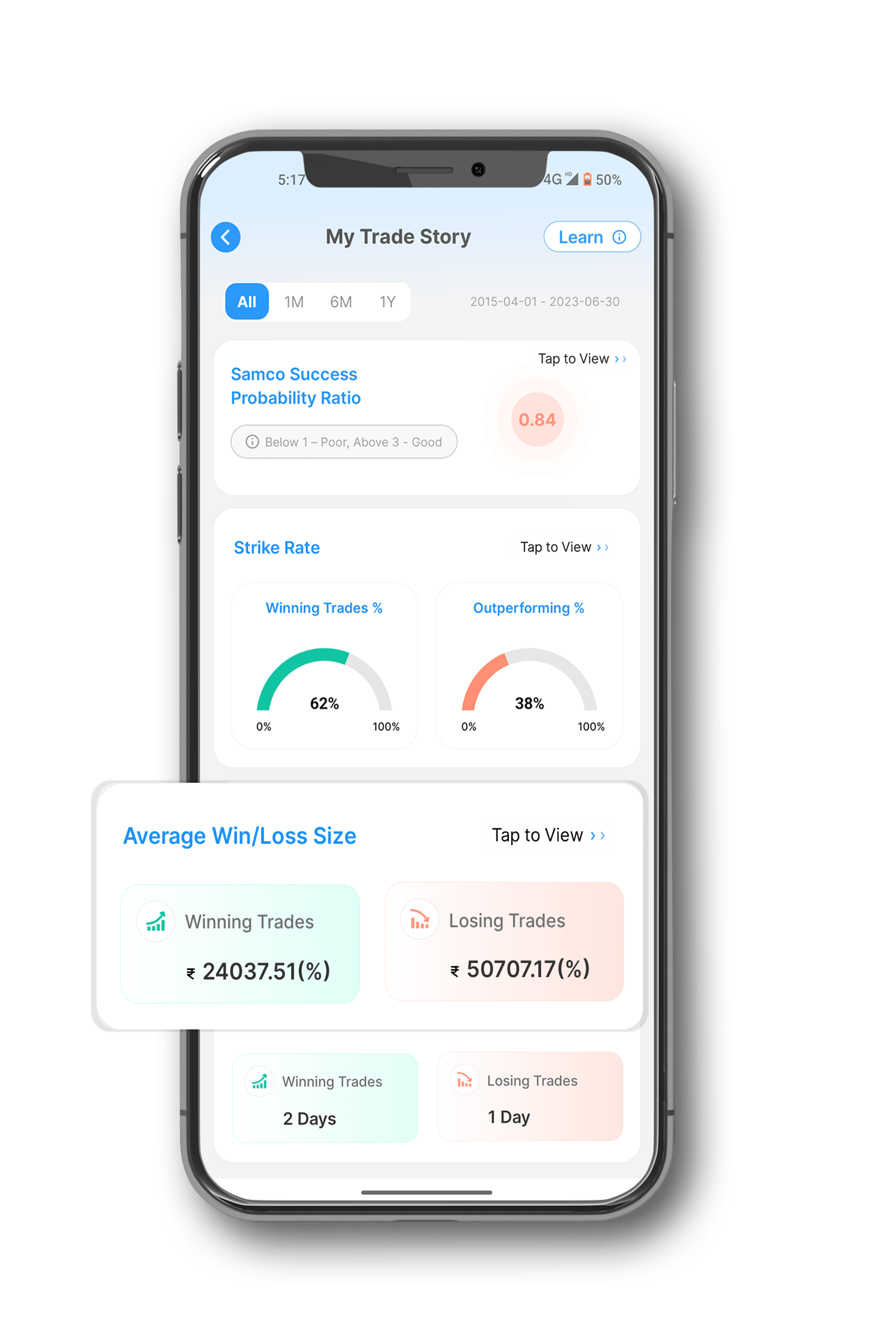In this Article, we will disucss:
- Key Trading and Investing Lessons from Market Experts
- The One Golden Rule That Sets Market Leaders Apart
- Average Holding Period: A Crucial Insight to Follow the Golden Rule
- Track Your Winning and Losing Days with Samco’s New-Gen Trading App
- Choose Samco Today to Make the Golden Rule a Natural Part of Your Trading Strategy
What do Rakesh Jhunjhunwala, Warren Buffet, Radhakishan Damani and George Soros all have in common?
They’re all role models that every trader and investor eager to earn profits in the stock market looks up to.
If you’re serious about becoming a successful trader, you may have spent hours looking into the biggest trades of these share market greats. Imitating the playbook of these successful traders may work in some scenarios and backfire in others. However, rather than replicating their traders, it’s their strategies and principles that you must aim to emulate.
Key Trading and Investing Lessons from Market Experts
If you’re not sure where to begin, here are some valuable guidelines that most top traders and investors swear by.
Keep Emotions out of the Equation
When he turned 50, Rakesh Jhunjhunwala famously remarked in an interview that his emotions were reserved for his family, not for his stocks. This is important for traders and investors from all demographics. Once you bring emotions like panic or greed into the equation, your trades are no longer objective or data-driven.
Don’t be Afraid to Go Against the Tide
Do you align your trades with the prevailing market trend? Or are you comfortable going against the market? If you are afraid of the latter, here’s a vital lesson from Rakesh Jhunjhunwala — it’s alright to buy when others are selling and sell when others are buying. Following the herd may not always be a smart thing to do.
The Bear Market is Nothing to Fear
The bear market is a source of fear for most traders. Witnessing stock prices dipping day after day can trigger panic selling. However, Damani staunchly believes that the bear market also offers many opportunities for traders to purchase stocks and assets at low prices. For individuals interested in intraday trading, bearish phases are also excellent periods to go short.
Don’t Lose Money
This is one of Warren Buffet’s most famous lessons. It may seem like an obvious benchmark to follow, but implementing it practically is easier said than done for most traders. Every trade carries an inherent risk, but to ensure you do not lose money, you need to know when to cut your losses.
The One Golden Rule That Sets Market Leaders Apart
The lessons outlined above are undoubtedly vital for trading success. However, there’s one crucial area in which most traders are prone to poor decision-making. In fact, when compared to top traders, the average retail trader may make the exact opposite decision in this situation.
Let us understand this better with an example. Say you’re into stock and options trading and you have two open positions in the market, as follows:
Position 1:
This trading position is in the derivatives market. It’s currently in the green zone and shows a profit of Rs. 2,00,000.
Position 2:
This trading position is in the cash segment. It’s currently in the red zone and shows a loss of Rs. 1,20,000.
In this case, you will most likely close position 1 because you may want to take home the profits as soon as possible. As for position 2, you are likely to keep it open hoping that the losses will reduce over time. Interestingly, a seasoned trader or market expert will do the exact opposite. They will let their profitable trading positions run and exit loss-making trades at the earliest.
This brings us to the golden rule that market experts firmly believe in:
Let your winners run and cut your losses on time.
It’s one of the most enduring guidelines on Wall Street and Dalal Street. If you apply this rule to the example we discussed earlier, it means that you will have to keep position 1 open so your profits can add up, and close position 2 so your losses are cut short before they become too high. Let’s decode each part of this golden rule further.
What Does it Mean to ‘Let Your Winners Run?’
This part of the golden rule emphasizes the importance of maximizing gains from your profitable trades. You need to resist the temptation to close a winning position too early. Successful traders understand that big gains often come from a few winning trades, so they give these trades more room to grow. To implement this strategy, you need patience and the ability to withstand market fluctuations without succumbing to short-term fears or panic.
What Does it Mean to ‘Cut Your Losses Short?’
Cutting your losses short is about minimizing the impact of failing trades. To implement this online trading strategy, you can use stop-loss orders to automatically exit trades when they hit a certain loss level. This prevents a small deficit from turning into a catastrophic loss and preserves your capital for future investments. It also allows you to avoid emotional decision-making like hoping for an uptick in a continuously declining market.
Average Holding Period: A Crucial Insight to Follow the Golden Rule
To check if you’re following the golden rule and letting your winners run while cutting your losses short, there’s one key metric that you need to trade — the average holding period for your trades.
It represents the average number of days over which you hold your winning trades and losing positions. The number of days you hold your winning trades are considered winning days, while the number of days you hold on to losing positions are considered losing days. Ideally, your winning days should exceed your losing days.
If it’s the other way around, it indicates that you spend most of your trading days holding on to losing positions, when you could have otherwise utilized them to focus on winning trades instead.
Track Your Winning and Losing Days with Samco’s New-Gen Trading App
The concept of the average holding period may be simple. However, if you need to practically track the total number of winning and losing days for each trade you make during a month or any given period, it can quickly become challenging. You may lose valuable time tracking these insights manually, or worse, you could make errors in your calculation — leading to wrong conclusions about the success or failure of your trading strategy.
Here’s where Samco Securities can be a game-changer. With our new-gen trading app, you can evaluate your winning and losing days strategy-wise, sector-wise and market cap-wise.
The app shows you the average holding period for your trades at all these levels, so you can easily access unseen insights about how long you’re holding on to losing trades and how quickly you’re exiting profitable positions. This will help you optimize your holding period for better trading outcomes.
That’s not all. With the trend analysis feature in the app, you can emulate the lesson put across by Rakesh Jhunjhunwala and include trades that go against the market trend as a part of your overall strategy. The ‘Trade v/s Trend’ feature tells you how many of your trades that aligned with the trend were successful, and how many of those that were against the trend were profitable. By comparing these insights, you can get a better idea of how well you understand market trends and improve in this area if necessary.
Choose Samco Today to Make the Golden Rule a Natural Part of Your Trading Strategy
Letting your winners run and cutting your losses short is easier said than done because of the natural human tendency to hope for better outcomes even in disadvantageous situations. This is why it’s essential to have a data-driven approach that encourages you to follow this golden rule at every stage of your trading journey.
With Samco’s new-gen online trading app, this is precisely what you get. For any given period, you can access insights about the number of days during which you held winning and losing trades. Interpreting these results is simple. Ideally, you should be letting your winners run, so the higher your winning days, the better. And you should be cutting your losses, meaning that the fewer your losing days are, the better.
It’s that simple. And the best part is that you get all these insights and more free of cost with Samco Securities. So, it’s never too late to choose our new-gen trading app to upgrade your trading performance to the level of market experts. Open a demat account and trading account with Samco today, and download our app to access all these insightful features and more at your fingertips!
Disclaimer: INVESTMENT IN SECURITIES MARKET ARE SUBJECT TO MARKET RISKS, READ ALL THE RELATED DOCUMENTS CAREFULLY BEFORE INVESTING. The asset classes and securities quoted in the film are exemplary and are not recommendatory. SAMCO Securities Limited (Formerly known as Samruddhi Stock Brokers Limited): BSE: 935 | NSE: 12135 | MSEI- 31600 | SEBI Reg. No.: INZ000002535 | AMFI Reg. No. 120121 | Depository Participant: CDSL: IN-DP-CDSL-443-2008 CIN No.: U67120MH2004PLC146183 | SAMCO Commodities Limited (Formerly known as Samruddhi Tradecom India Limited) | MCX- 55190 | SEBI Reg. No.: INZ000013932 Registered Address: Samco Securities Limited, 1004 - A, 10th Floor, Naman Midtown - A Wing, Senapati Bapat Marg, Prabhadevi, Mumbai - 400 013, Maharashtra, India. For any complaints Email - grievances@samco.in Research Analysts -SEBI Reg.No.-INHO0O0005847






 Easy & quick
Easy & quick
Leave A Comment?